Page Contents:
What is Green Infrastructure?
Why do we need this GI Assessment?
How has the GI Assessment been developed?
Why was a settlement based approach adopted?
Overview of the Green Infrastructure Assessment
What is Green Infrastructure?
1.4 As defined within Planning Policy Wales (Edition 11) (Opens in new window), Green Infrastructure (GI) refers to “the network of natural and semi-natural features, green spaces, rivers and lakes that intersperse and connect places”.
1.5 Just as a transport network connects people across and area through a network of roads, rail or pavements, GI helps to connect people, wildlife and nature. GI can therefore include strategic scale assets such as river corridors as well as parks, woodlands, private gardens, allotments, hedges, street trees, roadside green verges, or footpaths.
1.6 The figure below depicts the multifunctional nature of green infrastructure, which can include:
- Woodland
- Street trees and verges
- Cemeteries and churchyards
- Beaches and coastline
- Used and disused railway lines
- Raised planters and pocket parks
- Heathland and grassland
- Hedgerows/agricultural land
- Private gardens
- River corridors and wetlands
- Parks, spaces and sports facilities
- Green roofs and green walls
- Allotments and orchards
- Footpaths and cycleways
Figure 1.1: Multi-functional nature of Green Infrastructure
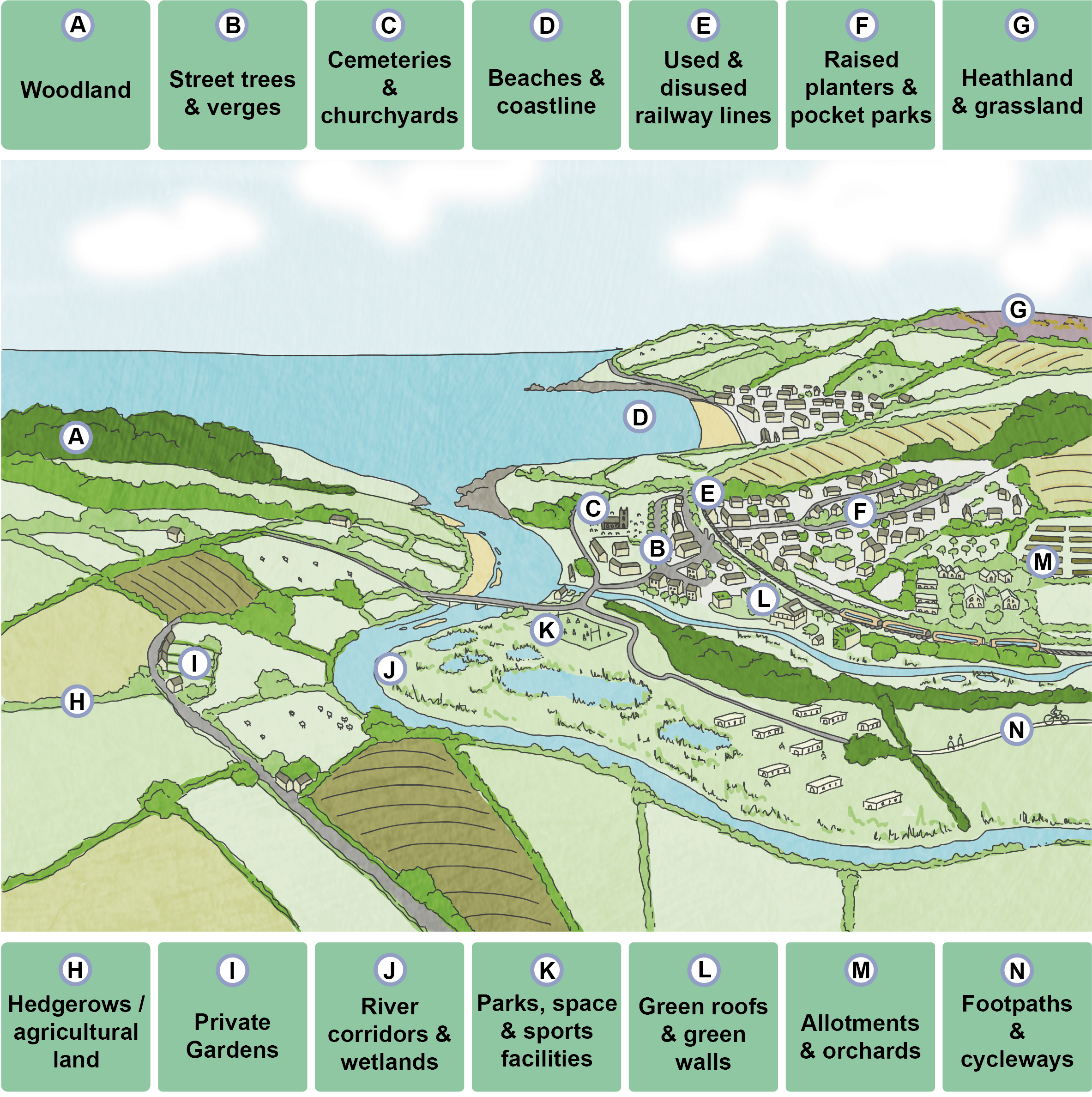
1.7 Recognition of the multi-functional nature of GI is also of particular importance. When considering any given GI asset, it is likely that several functions will be identified, and several benefits derived. For instance, a high-quality urban park will likely provide opportunities for informal recreation, support active travel, provide education opportunities, space for wildlife, reduce surface water run-off and mitigate air pollution.
1.8 GI should form a strategic network of high-quality green spaces and other natural features, which offer quality of life benefits for communities. It should thread through the built environment and connect the urban area to wider rural areas. Recognised as an essential component of resilient and healthy communities, the concept of GI, therefore, forms a cornerstone of sustainable development.
1.9 The figure below depicts some of the benefits of green infrastructure, which include:
- Reduction of the risk of flooding
- Enhancement of water quality
- investment and enhanced visitor experience
- Spaces for wildlife and ecological resilience
- Urban cooling
- Social interactions and community cohesion
- Carbon sequestration and climate mitigation
- Improvement of health and wellbeing
- Reinforcement of a sense of place
- Play, education and interaction with nature
- Enhancement of air quality and noise regulation
- Provision of active travel opportunities
Figure 1.2: Benefits of Green Infrastructure
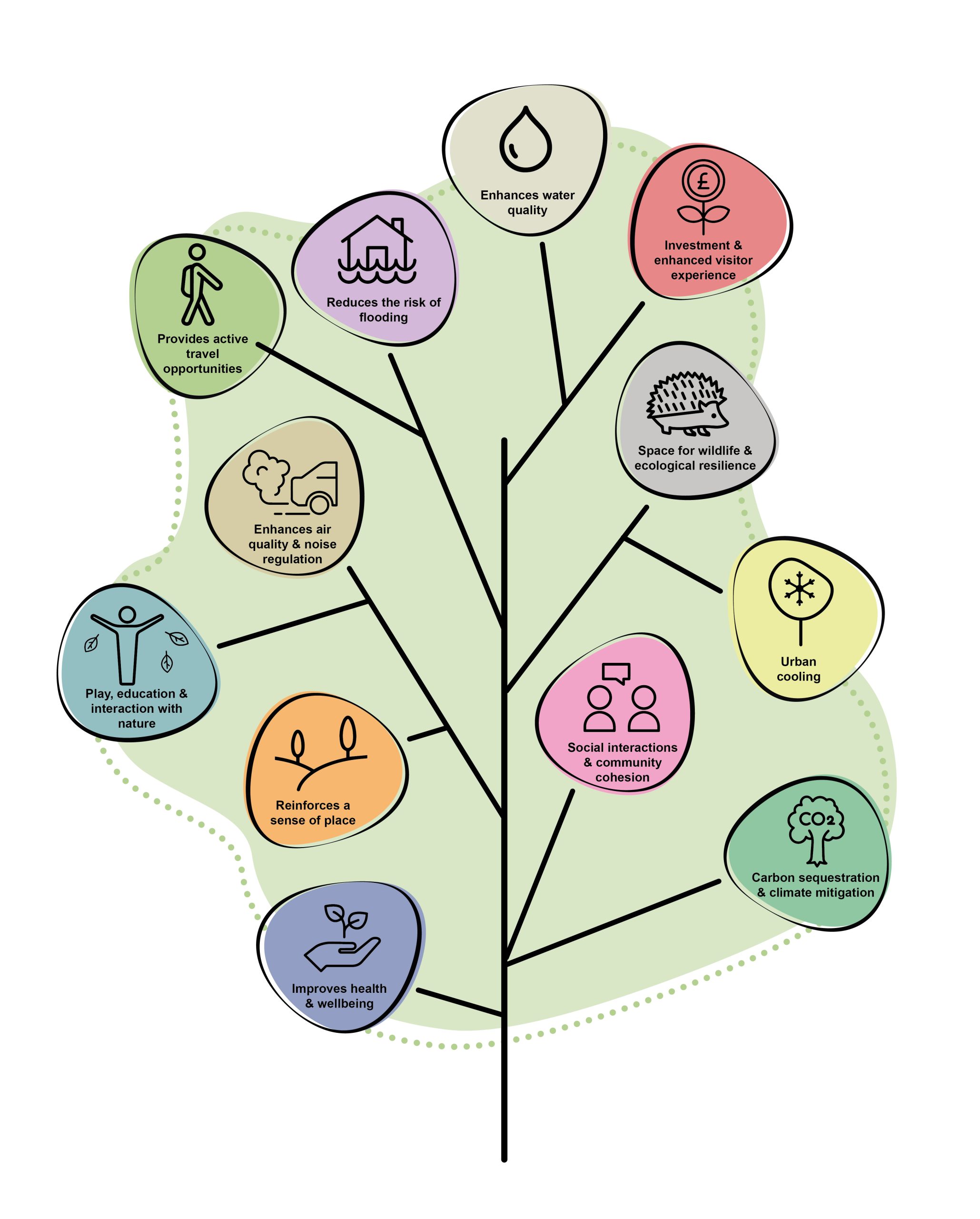
Why do we need this GI Assessment?
1.10 At a national scale, the evolving policy context in Wales ensures that GI is receiving greater attention than ever before. Future Wales (Opens in new window) is the Welsh Government’s National Development Framework and is the highest tier of the Development Plan in Wales. As the most recent expression of national planning policy, Future Wales is considered to have primacy in the planning policy hierarchy. The Local Development Plan is therefore required to ensure conformity. The purpose of Future Wales is to ensure the planning system at all levels is consistent with, and supports the delivery of, Welsh Government strategic aims and policies. The key policies of relevance to GI are Policies 2, 8 and 9. Policy 2 states that “the growth and regeneration of towns and cities should positively contribute towards building sustainable places that support active and healthy lives, with urban neighbourhoods that are compact and walkable, organised around mixed‑use centres and public transport, and integrated with green infrastructure”.
1.11 Policy 8 notes that flood risk management that enables and supports sustainable strategic growth will be supported, including the promotion of nature-based solutions as a priority. Furthermore, the requirement for biodiversity enhancements, increased ecosystem resilience and provision of GI is outlined in Policy 9. This includes the identification of GI opportunities with the aim of delivering sustainable growth, ecological connectivity, social equality and well-being. The Preseli Hills and the woodlands of northern Pembrokeshire are specifically highlighted as an ecosystem service hotspot, offering multifunctional benefits at the strategic scale.
1.12 In 2015, the Welsh government passed the Well-being of Future Generations (Wales) Act 2015 (Opens in new window). This Act gives national and local government a legally binding common objective to work together to improve health and well-being in Wales, via seven well-being goals. Delivery of GI at a settlement scale therefore requires alignment with this existing policy and strategy base. This ensures that proposed GI interventions are based on the taxonomy of the Well-being of Future Generations Goals and rooted in other national, regional and local policies.
1.13 Delivery of nature-based solutions and proposals to increase GI in and around urban areas are highlighted as national priorities within Natural Resources Policy (Opens in new window). Other key legal frameworks and national planning policy documents in Wales (including the Active Travel (Wales) Act 2013 (Opens in new widnow) and legislation such as Wales’ pioneering SuDS regulations (Opens in new window) and the State of Natural Resources Report for Wales (Opens in new window)) provide a framework for future investment in GI.
1.14 The Environment (Wales) Act 2016 (Opens in new window) also includes a new biodiversity duty with the aim to help reverse the decline and secure long-term resilience of biodiversity in Wales. This highlights the key issue of biodiversity pressures and the need to enhance ecosystem resilience in Wales, supporting the delivery of the Local Biodiversity Action Plan at the local level. The Act forms a core consideration in decision making and provides a framework that ensures Wales’ natural resources are managed sustainably.
1.15 At the national level, the State of Natural Resources Report for Wales (Opens in new window) identified the nature and climate emergencies as the two key strategic environmental challenges for Wales to address. Climate change and flooding are also key issues impacting the urban context of Pembrokeshire, and one of the Strategic Objectives to delivering the Vision of the PCC Local Development Plan (Opens in new window) is to mitigate and respond to climate change. The PCNPA Local Development Plan also highlights climate change, sustainable design, flooding and sustainable energy as priority issues within the county.
1.16 The key factors influencing the need for the GI Assessment are based on the ‘themes’ identified within the South West Wales Area Statement (Opens in new window) published by Natural Resources Wales (NRW), as defined below in Figure 1.3 and described in the paragraphs that follow after the figure.
Figure 1.3: South West Wales Area Statement Themes
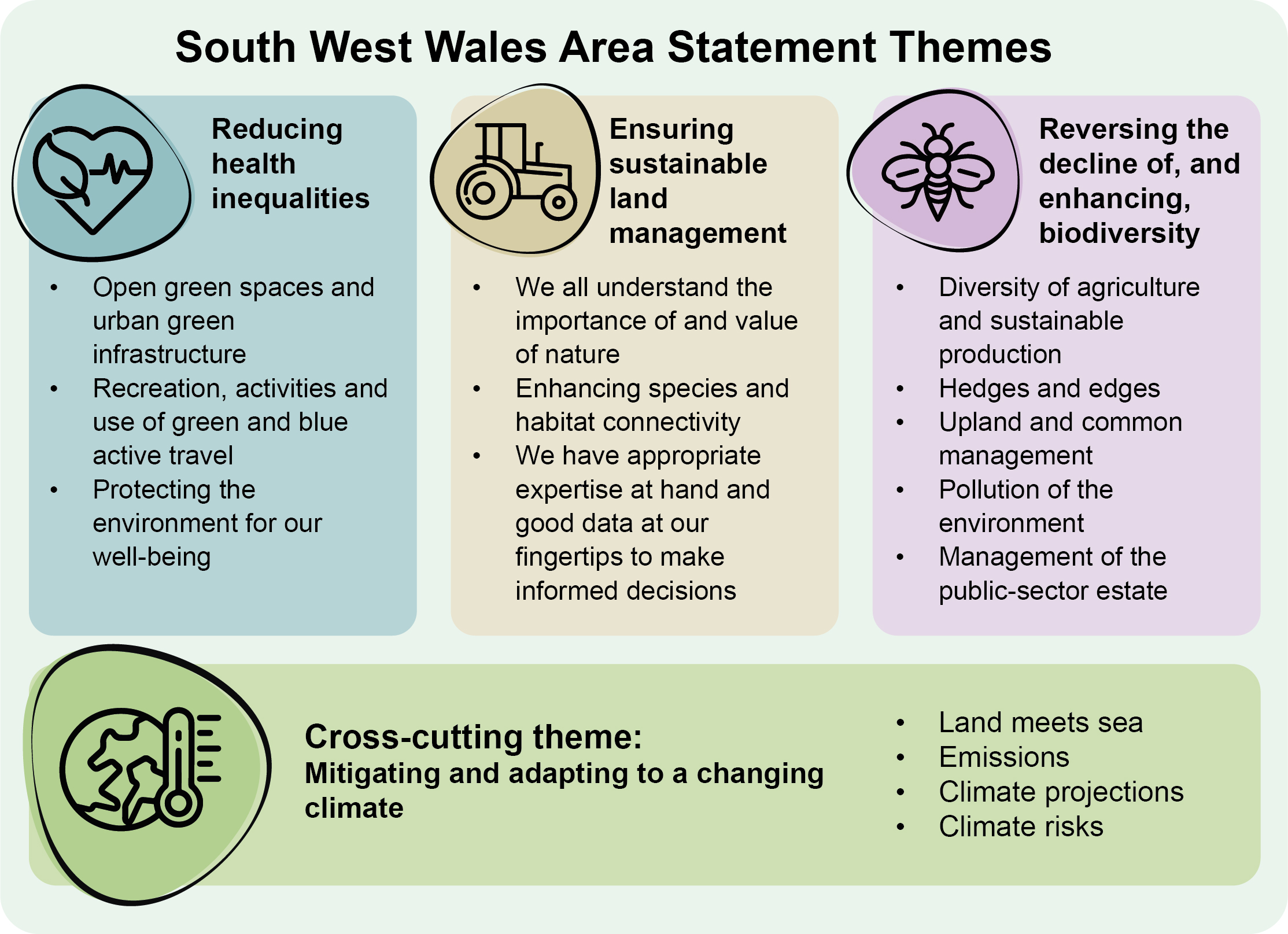
Mitigating and adapting to a changing climate
1.17 Climate change and its associated risks are a significant consideration for the county, particularly following the declaration of a climate emergency by both PCC and PCNPA in 2019. The requirement also exists to respond to the county’s wider commitment to achieving net zero by 2030. Investment in GI offers the potential to reduce Pembrokeshire’s vulnerability to climate change and other environmental threats, such as flooding. This is supported by a strong evidence base, including the Natural Resources Wales (NRW) State of the Natural Resources Report.
1.18 Published in 2022, the Pembrokeshire Well-being Assessment (Opens in new window) describes climate change and the nature emergency as the defining issues of our time. The effects of climate change will increase the significant number of properties, communities, infrastructure and key services at risk of flooding within the county. A number of settlements in Pembrokeshire are already facing adverse problems relating to climate change, hence a holistic approach is required to address these issues. GI interventions therefore have a key role to play in responding to climatic variability and change.
Reversing the decline of, and enhancing, biodiversity
1.19 Climate change and its associated risks are a significant consideration for the county, particularly following the declaration of a climate emergency by both PCC and PCNPA in 2019. The requirement also exists to respond to the county’s wider commitment to achieving net zero by 2030. Investment in GI offers the potential to reduce Pembrokeshire’s vulnerability to climate change and other environmental threats, such as flooding. This is supported by a strong evidence base, including the State of Natural Resources Report for Wales (Opens in new window).
1.20 Published in 2022, the Pembrokeshire Well-being Assessment (Opens in new window) describes climate change and the nature emergency as the defining issues of our time. The effects of climate change will increase the significant number of properties, communities, infrastructure and key services at risk of flooding within the county. A number of settlements in Pembrokeshire are already facing adverse problems relating to climate change, hence a holistic approach is required to address these issues. GI interventions therefore have a key role to play in responding to climatic variability and change.
Reducing health inequalities
1.21 The Well-being Plan for Pembrokeshire (Opens in new window) promotes the environment as a key resource to improve health and well-being, address social isolation, enhance mental health and deliver projects such as social and green prescribing. In addition to improving general health outcomes, the report states that enhancing the public’s relationship with nature offers the opportunity to directly enhance their attitudes and behaviours concerning environmental sustainability.
1.22 The expansion and improvement of GI provides a mechanism to tackle health and economic inequalities as well as support community cohesion. All of Pembrokeshire’s settlements offer a wide range of GI assets that provide health and well-being benefits which could be further enhanced through appropriate GI interventions.
Ensuring sustainable land management
1.23 Whilst the focus of the GI Assessment is on the identification of GI interventions at the settlement scale, the way in which land is managed has wider implications on the county. Diversity of agriculture and sustainable production forms a key issue, with sustainable approaches to forestry and farming potentially offering huge benefits to the environment. These include a reversal in the decline of biodiversity, reduced flood risks and improvements to the quality of water resources. The opportunity also exists to increase the potential for carbon sequestration within soils and biomass, through the protection and enhancement of existing assets.
How has the GI Assessment been developed?
1.24 The development of the GI Assessment has involved the evaluation of the existing baseline and identification of opportunities for improvement. The approach has included five steps, as outlined within the GI Assessments Guidance Note 42 published by NRW. This process was used to compile the evidence base to help develop and identify GI interventions.
Setting the baseline
1.25 The first step in the development of the GI Assessment was the identification of existing GI assets, ecological corridors and strategic networks within Pembrokeshire. Baseline spatial data was gathered from a wide range of sources, including NRW, and collated using Geographical Information Systems (GIS).
Identifying priorities
1.26 This stage involved the analysis of the spatial distribution of the existing GI network, as well as the socio-economic and environmental context which contributes to the ‘need’ for GI within Pembrokeshire. Datasets were analysed to identify risks and challenges within the county, providing the starting point for the identification of opportunities to improve the GI network. This information was supplemented with local priorities, risks and opportunities identified within the South West Wales Area Statement (Opens in new window), providing the drivers and strategic context for the Studies.
1.27 Consultation and engagement formed a critical component in the development of the GI Assessment. This was used to supplement the data analysis and involved engagement with key stakeholders via a series of virtual workshops, targeted consultation and site visits. These responses were used to inform the preparation of the emerging GI Assessment. Public consultation was also undertaken using an online survey and interactive map as a tool for gaining an insight into perceptions, opportunities and local expectations.
Site assessment
1.28 Field work was undertaken in order to identify site specific threats and challenges to project delivery. The 11 settlements were visited with the aim of identifying opportunities for maintaining and improving the GI network at a site level, complementing analysis at the strategic scale.
Identifying opportunities
1.29 Starting at the strategic scale, analysis was completed to address priorities relating to both biodiversity and people within Pembrokeshire. The findings were used to inform the identification of GI projects for the protection, enhancement, and expansion of the GI network. Specific emphasis was placed on the identification of opportunities to improve ecological resilience, the provision of ecosystem services and water management. Each of the GI projects were mapped and the functions of each action / project highlighted.
Delivery and monitoring / review
1.30 The development of the GI Assessment focussed on ensuring the delivery of GI interventions, including mechanisms to monitor future successes through performance indicators.
Figure 1.4: Approach to developing the studies and mapping GI
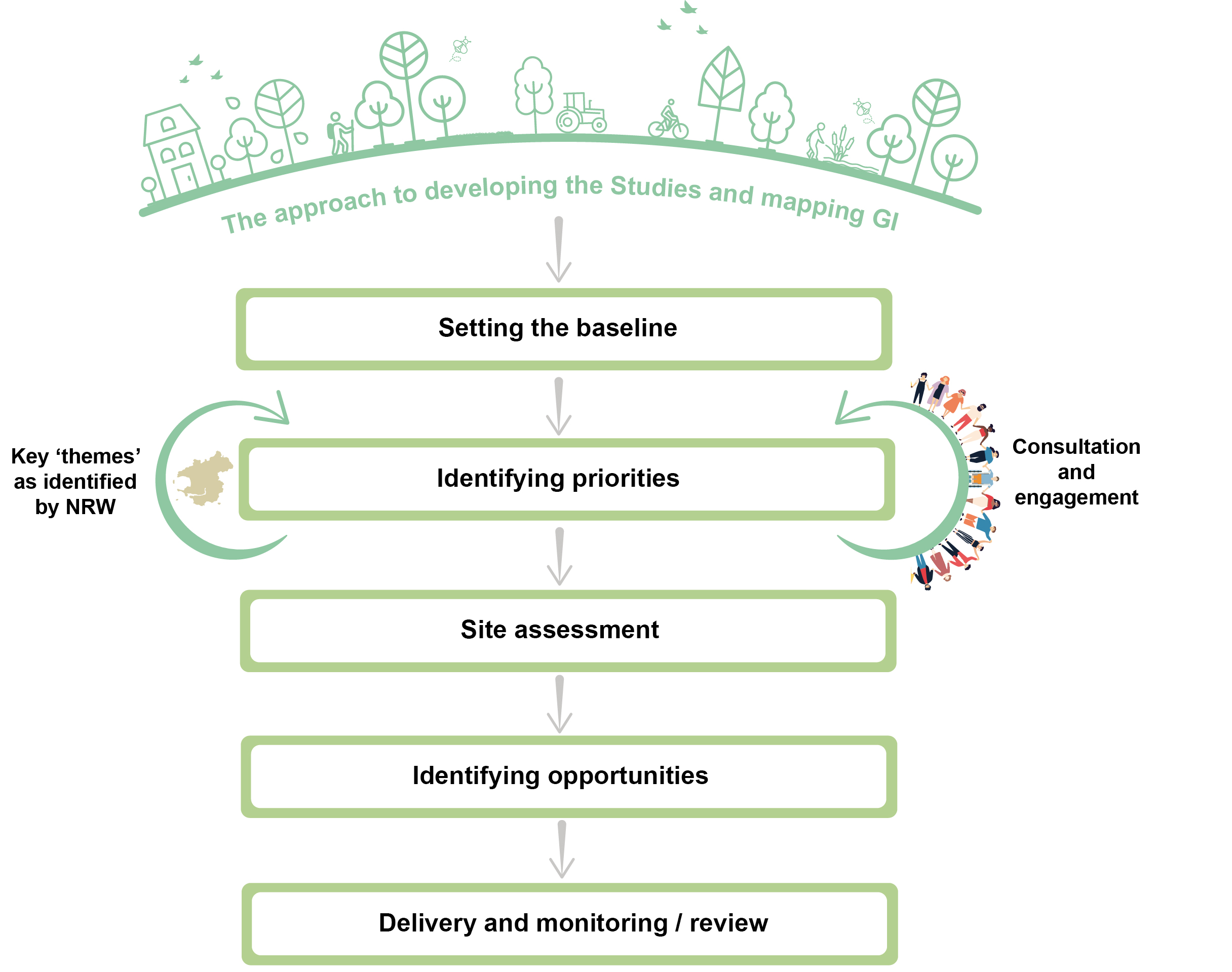
Why was a settlement based approach adopted?
1.31 This approach was used as it offered the greatest opportunity for delivering needs for people and the community. By outlining opportunities within the urban environment, the GI Assessment aims to assess the potential to enhance GI in Pembrokeshire’s key settlements and thereby encourage healthy and active living, boost local economic regeneration and increase the resilience of the natural environment. These ambitions also support the national challenges and opportunities identified within Natural Resources Policy (Opens in new window). These include helping to tackle health and economic inequalities, aiding community cohesion and delivering climate change mitigation and adaptation.
1.32 The State of Natural Resources Report for Wales (Opens in new window) indicates that increasing GI in and around urban areas delivers a wide range of benefits in terms of both ecosystem resilience and community well-being. The provision of increased canopy cover close to settlements is also recognised as offering greatest recreational and ecosystem service value. In addition, well planned GI within urban areas can provide relief from climatic extremes through shelter and shading as well as connectivity for biodiversity to adapt to climate change. Furthermore, the provision of urban focussed GI interventions helps to ensure communities benefit from healthy environments, supporting preventative approaches to health outcomes. This includes ensuring a particular focus is placed on key public health issues of transport related air and noise pollution as well as tackling physical inactivity and mental health through the provision of increased green space.
1.33 The 11 settlements included in the GI Assessment are listed below and displayed on the following map:
- Fishguard and Goodwick
- Haverfordwest
- Milford Haven
- Narberth
- Newport
- Neyland
- Pembroke
- Pembroke Dock
- Saundersfoot
- St Davids
- Tenby
Figure 1.5: 11 settlements included in the GI Assessment
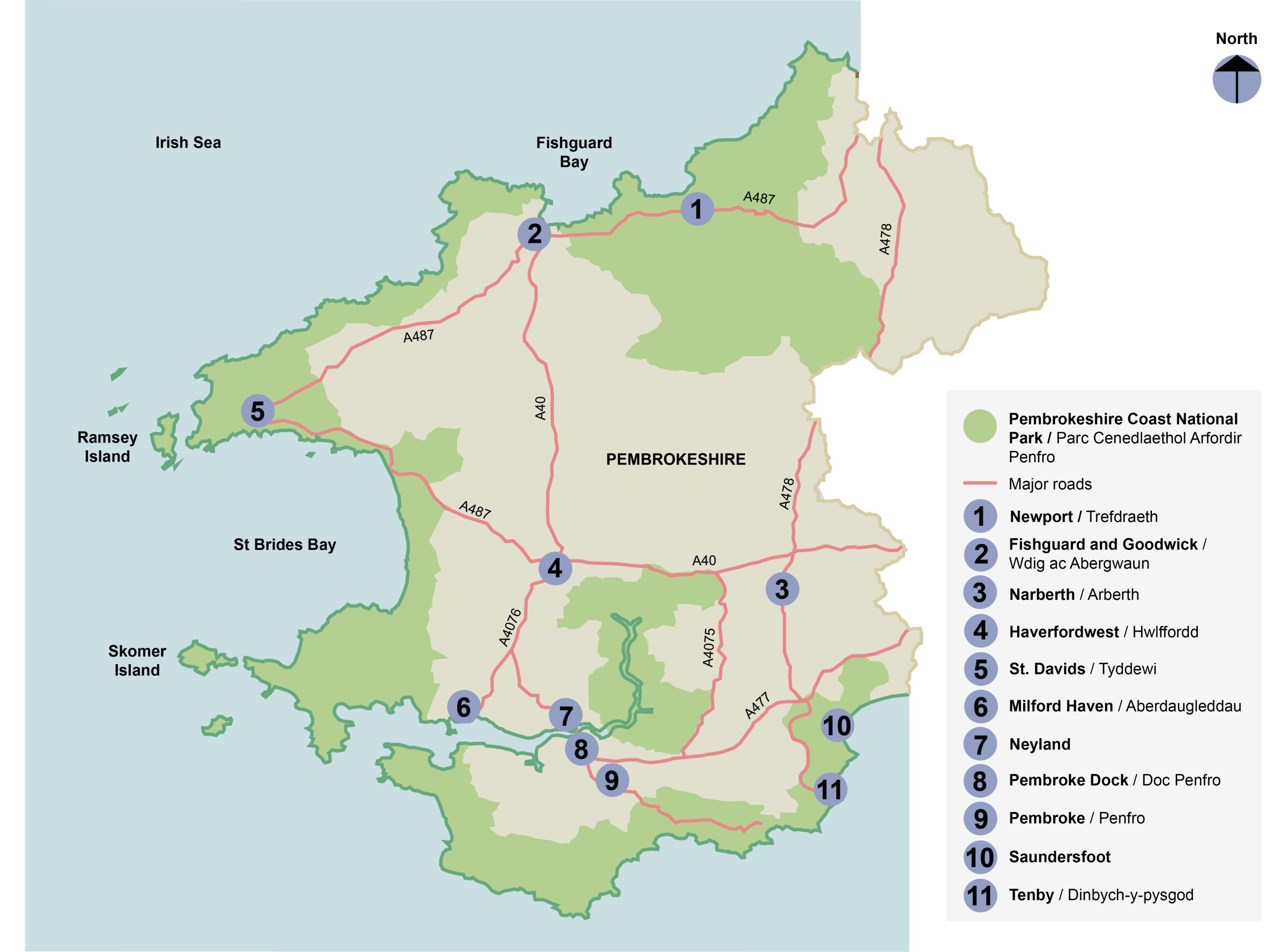
1.34 The GI Assessment builds on the work achieved to date as part of the Green Infrastructure Action Plan for Pembrokeshire (now superseded), with an increased emphasis on future management and delivery. The projects and opportunities outlined provide a road map for future investment and aim to guide the future delivery of GI ambitions across the county in the short, medium and long term.
1.35 The GI Assessment comprises three distinct elements (as listed below) which combine to inform GI at the strategic scale in Pembrokeshire:
- Settlement Management Plans
- Urban Tree Planting Strategies
- Pollinator Strategies
Figure 1.6: Three distinct elements of the GI Assessment
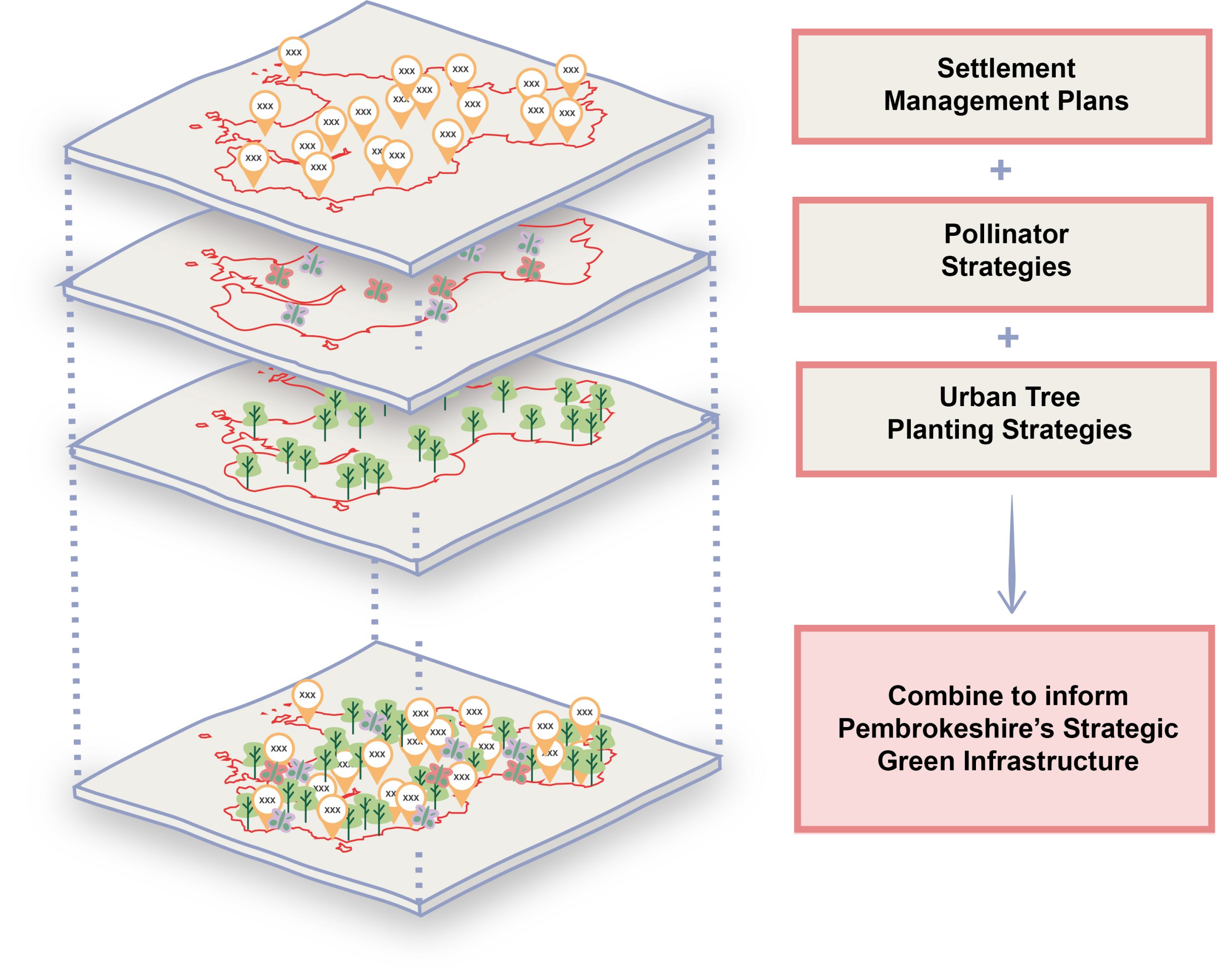
Return to homepage:
Homepage
Next Chapter:
Vision and Aims
